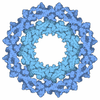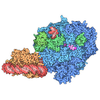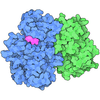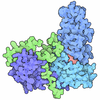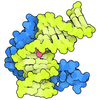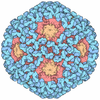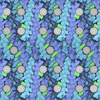[English] 日本語
 Yorodumi
Yorodumi- PDB-6vvo: Structure of the human clamp loader (Replication Factor C, RFC) b... -
+ Open data
Open data
- Basic information
Basic information
| Entry | Database: PDB / ID: 6vvo | ||||||||||||
|---|---|---|---|---|---|---|---|---|---|---|---|---|---|
| Title | Structure of the human clamp loader (Replication Factor C, RFC) bound to the sliding clamp (Proliferating Cell Nuclear Antigen, PCNA) | ||||||||||||
 Components Components |
| ||||||||||||
 Keywords Keywords | DNA BINDING PROTEIN / REPLICATION / sliding clamp / DNA replication / AAA+ / ATPase / clamp loader | ||||||||||||
| Function / homology |  Function and homology information Function and homology informationDNA clamp unloader activity / Elg1 RFC-like complex / DNA replication factor C complex / Ctf18 RFC-like complex / positive regulation of deoxyribonuclease activity / dinucleotide insertion or deletion binding / PCNA-p21 complex / mitotic telomere maintenance via semi-conservative replication / purine-specific mismatch base pair DNA N-glycosylase activity / DNA clamp loader activity ...DNA clamp unloader activity / Elg1 RFC-like complex / DNA replication factor C complex / Ctf18 RFC-like complex / positive regulation of deoxyribonuclease activity / dinucleotide insertion or deletion binding / PCNA-p21 complex / mitotic telomere maintenance via semi-conservative replication / purine-specific mismatch base pair DNA N-glycosylase activity / DNA clamp loader activity / nuclear lamina / positive regulation of DNA-directed DNA polymerase activity / Polymerase switching / MutLalpha complex binding / Processive synthesis on the lagging strand / PCNA complex / Telomere C-strand (Lagging Strand) Synthesis / Removal of the Flap Intermediate / Mismatch repair (MMR) directed by MSH2:MSH3 (MutSbeta) / Mismatch repair (MMR) directed by MSH2:MSH6 (MutSalpha) / Transcription of E2F targets under negative control by DREAM complex / Processive synthesis on the C-strand of the telomere / Polymerase switching on the C-strand of the telomere / replisome / response to L-glutamate / Removal of the Flap Intermediate from the C-strand / HDR through Single Strand Annealing (SSA) / DNA strand elongation involved in DNA replication / response to dexamethasone / DNA synthesis involved in DNA repair / Impaired BRCA2 binding to RAD51 / histone acetyltransferase binding / DNA polymerase processivity factor activity / G1/S-Specific Transcription / leading strand elongation / nuclear replication fork / replication fork processing / Presynaptic phase of homologous DNA pairing and strand exchange / SUMOylation of DNA replication proteins / PCNA-Dependent Long Patch Base Excision Repair / response to cadmium ion / ATP-dependent activity, acting on DNA / translesion synthesis / estrous cycle / telomere maintenance via telomerase / mismatch repair / Activation of ATR in response to replication stress / cyclin-dependent protein kinase holoenzyme complex / base-excision repair, gap-filling / DNA polymerase binding / epithelial cell differentiation / liver regeneration / TP53 Regulates Transcription of Genes Involved in G2 Cell Cycle Arrest / positive regulation of DNA repair / Translesion synthesis by REV1 / Translesion synthesis by POLK / positive regulation of DNA replication / replication fork / Translesion synthesis by POLI / nuclear estrogen receptor binding / Gap-filling DNA repair synthesis and ligation in GG-NER / male germ cell nucleus / enzyme activator activity / Termination of translesion DNA synthesis / Recognition of DNA damage by PCNA-containing replication complex / Translesion Synthesis by POLH / G2/M DNA damage checkpoint / receptor tyrosine kinase binding / HDR through Homologous Recombination (HRR) / DNA-templated DNA replication / Dual Incision in GG-NER / cellular response to xenobiotic stimulus / cellular response to hydrogen peroxide / Dual incision in TC-NER / Gap-filling DNA repair synthesis and ligation in TC-NER / cellular response to UV / response to estradiol / E3 ubiquitin ligases ubiquitinate target proteins / heart development / chromatin organization / Processing of DNA double-strand break ends / double-stranded DNA binding / Regulation of TP53 Activity through Phosphorylation / sequence-specific DNA binding / DNA-binding transcription factor binding / damaged DNA binding / DNA replication / chromosome, telomeric region / nuclear body / protein domain specific binding / DNA repair / centrosome / chromatin binding / chromatin / positive regulation of DNA-templated transcription / protein-containing complex binding / enzyme binding / negative regulation of transcription by RNA polymerase II / ATP hydrolysis activity / DNA binding Similarity search - Function | ||||||||||||
| Biological species |  Homo sapiens (human) Homo sapiens (human) | ||||||||||||
| Method | ELECTRON MICROSCOPY / single particle reconstruction / cryo EM / Resolution: 3.4 Å | ||||||||||||
 Authors Authors | Gaubitz, C. / Liu, X. / Stone, N.P. / Kelch, B.A. | ||||||||||||
| Funding support |  United States, United States,  Switzerland, 3items Switzerland, 3items
| ||||||||||||
 Citation Citation |  Journal: Proc Natl Acad Sci U S A / Year: 2020 Journal: Proc Natl Acad Sci U S A / Year: 2020Title: Structure of the human clamp loader reveals an autoinhibited conformation of a substrate-bound AAA+ switch. Authors: Christl Gaubitz / Xingchen Liu / Joseph Magrino / Nicholas P Stone / Jacob Landeck / Mark Hedglin / Brian A Kelch /  Abstract: DNA replication requires the sliding clamp, a ring-shaped protein complex that encircles DNA, where it acts as an essential cofactor for DNA polymerases and other proteins. The sliding clamp needs to ...DNA replication requires the sliding clamp, a ring-shaped protein complex that encircles DNA, where it acts as an essential cofactor for DNA polymerases and other proteins. The sliding clamp needs to be opened and installed onto DNA by a clamp loader ATPase of the AAA+ family. The human clamp loader replication factor C (RFC) and sliding clamp proliferating cell nuclear antigen (PCNA) are both essential and play critical roles in several diseases. Despite decades of study, no structure of human RFC has been resolved. Here, we report the structure of human RFC bound to PCNA by cryogenic electron microscopy to an overall resolution of ∼3.4 Å. The active sites of RFC are fully bound to adenosine 5'-triphosphate (ATP) analogs, which is expected to induce opening of the sliding clamp. However, we observe the complex in a conformation before PCNA opening, with the clamp loader ATPase modules forming an overtwisted spiral that is incapable of binding DNA or hydrolyzing ATP. The autoinhibited conformation observed here has many similarities to a previous yeast RFC:PCNA crystal structure, suggesting that eukaryotic clamp loaders adopt a similar autoinhibited state early on in clamp loading. Our results point to a "limited change/induced fit" mechanism in which the clamp first opens, followed by DNA binding, inducing opening of the loader to release autoinhibition. The proposed change from an overtwisted to an active conformation reveals an additional regulatory mechanism for AAA+ ATPases. Finally, our structural analysis of disease mutations leads to a mechanistic explanation for the role of RFC in human health. | ||||||||||||
| History |
|
- Structure visualization
Structure visualization
| Movie |
 Movie viewer Movie viewer |
|---|---|
| Structure viewer | Molecule:  Molmil Molmil Jmol/JSmol Jmol/JSmol |
- Downloads & links
Downloads & links
- Download
Download
| PDBx/mmCIF format |  6vvo.cif.gz 6vvo.cif.gz | 506.1 KB | Display |  PDBx/mmCIF format PDBx/mmCIF format |
|---|---|---|---|---|
| PDB format |  pdb6vvo.ent.gz pdb6vvo.ent.gz | 385.6 KB | Display |  PDB format PDB format |
| PDBx/mmJSON format |  6vvo.json.gz 6vvo.json.gz | Tree view |  PDBx/mmJSON format PDBx/mmJSON format | |
| Others |  Other downloads Other downloads |
-Validation report
| Summary document |  6vvo_validation.pdf.gz 6vvo_validation.pdf.gz | 1.1 MB | Display |  wwPDB validaton report wwPDB validaton report |
|---|---|---|---|---|
| Full document |  6vvo_full_validation.pdf.gz 6vvo_full_validation.pdf.gz | 1.2 MB | Display | |
| Data in XML |  6vvo_validation.xml.gz 6vvo_validation.xml.gz | 68.7 KB | Display | |
| Data in CIF |  6vvo_validation.cif.gz 6vvo_validation.cif.gz | 104.1 KB | Display | |
| Arichive directory |  https://data.pdbj.org/pub/pdb/validation_reports/vv/6vvo https://data.pdbj.org/pub/pdb/validation_reports/vv/6vvo ftp://data.pdbj.org/pub/pdb/validation_reports/vv/6vvo ftp://data.pdbj.org/pub/pdb/validation_reports/vv/6vvo | HTTPS FTP |
-Related structure data
| Related structure data |  21405MC M: map data used to model this data C: citing same article ( |
|---|---|
| Similar structure data |
- Links
Links
- Assembly
Assembly
| Deposited unit | 
|
|---|---|
| 1 |
|
- Components
Components
-Replication factor C subunit ... , 5 types, 5 molecules ABCDE
| #1: Protein | Mass: 66221.227 Da / Num. of mol.: 1 / Fragment: UNP residues 556-1148 Source method: isolated from a genetically manipulated source Source: (gene. exp.)  Homo sapiens (human) / Gene: RFC1, RFC140 / Production host: Homo sapiens (human) / Gene: RFC1, RFC140 / Production host:  |
|---|---|
| #2: Protein | Mass: 39203.207 Da / Num. of mol.: 1 Source method: isolated from a genetically manipulated source Source: (gene. exp.)  Homo sapiens (human) / Gene: RFC2 / Production host: Homo sapiens (human) / Gene: RFC2 / Production host:  |
| #3: Protein | Mass: 38545.512 Da / Num. of mol.: 1 Source method: isolated from a genetically manipulated source Source: (gene. exp.)  Homo sapiens (human) / Gene: RFC5 / Production host: Homo sapiens (human) / Gene: RFC5 / Production host:  |
| #4: Protein | Mass: 39751.668 Da / Num. of mol.: 1 Source method: isolated from a genetically manipulated source Source: (gene. exp.)  Homo sapiens (human) / Gene: RFC4 / Production host: Homo sapiens (human) / Gene: RFC4 / Production host:  |
| #5: Protein | Mass: 40614.332 Da / Num. of mol.: 1 Source method: isolated from a genetically manipulated source Source: (gene. exp.)  Homo sapiens (human) / Gene: RFC3 / Production host: Homo sapiens (human) / Gene: RFC3 / Production host:  |
-Protein , 1 types, 3 molecules FGH
| #6: Protein | Mass: 28795.752 Da / Num. of mol.: 3 Source method: isolated from a genetically manipulated source Source: (gene. exp.)  Homo sapiens (human) / Gene: PCNA / Production host: Homo sapiens (human) / Gene: PCNA / Production host:  |
|---|
-Non-polymers , 3 types, 9 molecules 
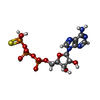
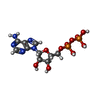


| #7: Chemical | ChemComp-MG / #8: Chemical | ChemComp-AGS / #9: Chemical | ChemComp-ADP / | |
|---|
-Details
| Has ligand of interest | Y |
|---|---|
| Has protein modification | Y |
-Experimental details
-Experiment
| Experiment | Method: ELECTRON MICROSCOPY |
|---|---|
| EM experiment | Aggregation state: PARTICLE / 3D reconstruction method: single particle reconstruction |
- Sample preparation
Sample preparation
| Component | Name: Human Replication factor C (RFC) complex bound to the sliding clamp Proliferating cell nuclear antigen (PCNA) Type: COMPLEX Details: hRFC construct with a truncation of the A subunit's N-terminal region (missing residues 1-555) Entity ID: #1-#6 / Source: RECOMBINANT |
|---|---|
| Molecular weight | Value: 0.31 MDa / Experimental value: NO |
| Source (natural) | Organism:  Homo sapiens (human) Homo sapiens (human) |
| Source (recombinant) | Organism:  |
| Buffer solution | pH: 7.5 |
| Specimen | Embedding applied: NO / Shadowing applied: NO / Staining applied: NO / Vitrification applied: YES |
| Specimen support | Grid material: GOLD / Grid type: Quantifoil R0.6/1 |
| Vitrification | Cryogen name: ETHANE / Humidity: 95 % / Chamber temperature: 283.15 K |
- Electron microscopy imaging
Electron microscopy imaging
| Experimental equipment |  Model: Titan Krios / Image courtesy: FEI Company | |||||||||||||||||||||
|---|---|---|---|---|---|---|---|---|---|---|---|---|---|---|---|---|---|---|---|---|---|---|
| EM imaging | Accelerating voltage: 300 kV / Electron source:
| |||||||||||||||||||||
| Image recording |
|
- Processing
Processing
| Software |
| ||||||||||||||||||||||||||||||||||||
|---|---|---|---|---|---|---|---|---|---|---|---|---|---|---|---|---|---|---|---|---|---|---|---|---|---|---|---|---|---|---|---|---|---|---|---|---|---|
| EM software |
| ||||||||||||||||||||||||||||||||||||
| CTF correction | Type: PHASE FLIPPING AND AMPLITUDE CORRECTION | ||||||||||||||||||||||||||||||||||||
| Symmetry | Point symmetry: C1 (asymmetric) | ||||||||||||||||||||||||||||||||||||
| 3D reconstruction | Resolution: 3.4 Å / Resolution method: FSC 0.143 CUT-OFF / Num. of particles: 193934 Details: Multi-body refinement was used to generate 2 reconstructions that were combined Symmetry type: POINT | ||||||||||||||||||||||||||||||||||||
| Atomic model building | Protocol: OTHER / Space: REAL Details: Initial local fitting was peformed using UCSF Chimera, followed by manual model adjustment, then refinement in PHENIX. | ||||||||||||||||||||||||||||||||||||
| Refinement | Cross valid method: NONE Stereochemistry target values: GeoStd + Monomer Library + CDL v1.2 | ||||||||||||||||||||||||||||||||||||
| Displacement parameters | Biso mean: 63.28 Å2 | ||||||||||||||||||||||||||||||||||||
| Refine LS restraints |
|
 Movie
Movie Controller
Controller


 UCSF Chimera
UCSF Chimera

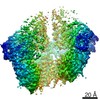

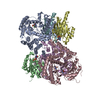

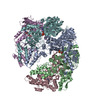
 PDBj
PDBj


